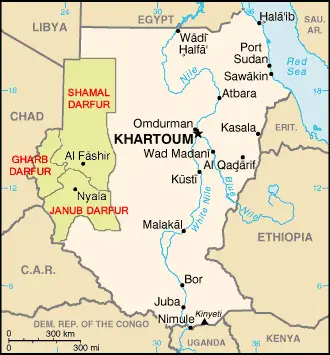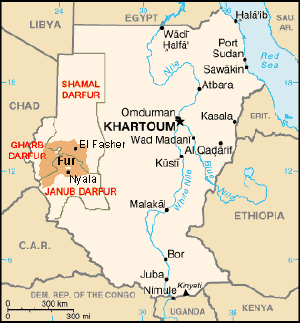Darfur
Darfur (Arabic دار فور is a region of Sudan, which borders the Central African Republic, Libya, and Chad along the Sudanese western border. Darfur, meaning "home of the Fur", is divided into three federal states: Gharb Darfur (West Darfur), Janub Darfur (South Darfur), and Shamal Darfur (North Darfur).
Background
Darfur extends from about 10 N. to 16° N. and from 21° E. to 27° 30' E, covering an area of approximately 150,000 sq. miles. For the basis of comparison, the Darfur region is geographically about three-quarters the size of Texas, more than half the size of Kenya or slightly smaller than France. Darfur has an estimated population of 7.4 million people.
Like many of the countries bordering the Sahara, the Darfur is dominated by a semiarid plateau that punctuated by occasional mountain ranges. The plateau is bordered along 24° E by the Jebel Marra mountain range that defines the region along the north-south border. The mountain range extends past the borders of Darfur, eventually reaching its highest point of between 5,000 to 6,000 feet. Towards the east the range loses its sharp definition and dissolves into a series of sandy steppes. The Darfur region also contains a high level of volcanic activity, which has significantly aided in forming most of the mountain ranges in the area. One volcanic range, the Jebel Medob lies to the north east of Jebel Marra and is continuously affected by volcanic activity in the region. Volcanic activity in Darfur also results in volcanic craters, the most notable of which is Bir-el-Melh, a crater that descends 50 ft. into the ground.
The rainy season in Darfur is from June to September, and it effectively transforms the dry arid plateau to a lush green that is rich with vegetation. The rains are a vital part of life in Darfur, helping the predominately agricultural society to grow a successful harvest of millet. Millet is the main crop of the region, and is used to feed both the human and livestock populations. Other main agricultural staples include cereals, fruit and tobacco as well as livestock in the drier north. Despite the need for rain, the northern parts of the region can go years without sufficient rainfall. In the far south the story is different, and the annual average rainfall is 700 mm [1]
Culture and Economy
The Darfur region is culturally divided along occupational lines, with the agricultural Fur people of the in the center, the former ruling class the Tunjur in the north, and Nilo-Saharan language speakers in the northwest who focus on animal husbandry as livelihood. The largest cultural groups in the northwest are the Berti people and the Zaghawa people. In the western portion of the Darfur region, the Masalit people have successfully maintained their cultural identity and remained independent from Dar Fur. In the early history of the region, a group of Arab camel herders traveled to the southern parts of the area to find an adequate source of rainfall. This group of people later merged with the Fulani people and became known as the Baggara [2]. Soon after the populations blended to form one cultural unit, the Baggara switched from raising cattle to raising horses. The Baggara developed a duel society, where portions of families were left in the south to cultivate the agricultural fields while a portion of the family took to herds to established grazing areas. On the way to specific area, some traders would allow their herds to seek refuge in fields found along the way, a practice that often required a mediator to step in to resolve conflicts [3].
Languages
Darfur, due to the huge variety of cultures of ethnic groups in the region, boasts a wide variety of languages within its borders. The main languages of Darfur include:
- Arabic, predominately found south of Nyala and in the eastern portions of Darfur, but smaller enclave of Arabic speakers are also found along the Chad border in a narrow strip north of Jebel Si, between Fur and Zaghawa;
- Daju, is only found in a small pocket near Nyala. It is an offshoot of the Western branch of the Eastern Sudanic group of the Nilo-Saharan language family;
- Erenga, considered a dialect of Tama, is found north of Geneina and across the border in Chad;
- Fongoro, is considered almost extinct as most speakers of the language have shifted to speaking Fur, the remaining speakers are found south of Sinyar.
- Fulbe, or Fulfulde, is only found in a small area south of Nyala;
- Fur, is located in the center of the region, reaching from Wadi Azum in the west to Al Fashir in the east. It belongs to the Fur language group of Nilo-Saharanlanguage family;
- Masalit, is located mostly west of Wadi Azum and around Geneina; it is also spoken across the border, and in a small isolated area south of Nyala. It belongs to the Maban language group of Nilo-Saharan family;
- Sinyar, is mostly found along the border south of Masalit. It is closely related to Fongoro;
- Tama, is only found in a small Tama speaking pocket between Jebel Si and Jebel Marra. It is closely related to Daju ;
- Zaghawa, is popular in the northern portions of Darfur;
History
The Daju people were the first cultural group to establish a permanent presence in the inhospitable Darfur region. In order to survive in the arid climate, the Daju settled into the Marrah Mountain range. By living in the mountains the Daju had steady access to water, necessary for the survival of any civilization. Despite the fact that the Daju created the first Darfuri civilization, little is known about the group. The only historical record of the civilization is a list of kings. In the fourteenth century the Daju fell to an Tunjur invasion, that significantly altered the political and religious structure of the region. In particular, the Tunjur invasion ushered in Islam to the region and instituted Muslim political dominance. The Tunjur also attempted to link their political system to the political history of the region by having their leader marry the daughter of the last Daju monarchy, thus adding legitimacy to their rule in the eyes of the Daju. The most notable leader in early Tunjun history is sultan Soleiman, who reigned from 1596 C.E. to 1637 C.E. He is considered the founder of the Keira dynasty, which led Darfur to become a formidable power in the Sahel. At the height of its expansion under the Keira dynasty, the Tunjun controlled an area reaching as far east as the Atbarah River. The power of the Tunjun began to decline in the end of the 18th century, marked by the military defeat of the sultan Mahommed Terab. Once a formidable military force, the armies of Tunjun were stopped at Omdurman and were unable to advance beyond the Nile. The inability to expand frustrated the expansionist tendencies of Terab, and he remained at Omduran for many months. He was poisoned by his wife at the instigation of disaffected chiefs, and the army returned to Darfur.
During the mid-18th century C.E. the many cultural and ethnic factions within Darfur proved to have conflicting goals. Divisions among groups were catastrophic for Darfur, leaving the region unable to survive external wars with the Sennar and the Wadai. The final blow for the weakened, independent Darfur took the form of a Egyptian invasion in 1875. Egypt was itself a colony under Great Britain, and perpetrated colonialism by setting up an Egyptian settlement in Khartoum.
Egyptian rule did not last long in Darfur, and Muhammad Ahmad soon rose to power as the leader of the region. His authority, however, was largely self proclaimed and not widely accepted. Muhammad Ahmad was succeeded to the throne by Adballahi ibn Muhammed, whose reign proved even more contentious among the population. He demanded that the pastoralist tribes under his control provide soldiers so that the royal court could further pursue an expansionist policy. The recruitment policy proved to be his downfall, and many tribes rose up in rebellion. The British government revitalized their presence in Darfur in response to the wide spread dissent in the region. British forces succeeded in overthrowing Adballahi in 1898 C.E. and instituted Ali Dinar as the British supported leader of Darfur. During World War One Great Britain began to fear that Darfur could fall under the control of Turkey, and incorporated the area into Sudan in 1916.
By 1956, the area was racked by political instability. Adding to the military threat from continual wars between Sudan, Libya and Chad, a new ideology propagated by Libyan president Muammar al-Gaddafi began to take hold in Darfur. This new ideology divided the population along artificial ethnic lines, identifying people as either "Africa" or "Arab". Ethnic conflict reached its height when a 1980s drought disrupted the existing social structures in the area. The 1980s brought about the first fighting in the area, a conflict which would continue in some degree for the next 15 years. Fighting reached its peak in 2003, when the Darfur Conflict devastated the country. The conflict soon came to be regarded as one of the worst humanitarian disasters in the world.
See also
- Friedhelm Eronat
- Darfur Conflict
- Darfur Information Retrieved July 18, 2007.
- BBC report on DarfurRetrieved July 18, 2007.
Foot Notes
- ↑ de Waal, Alex, Famine that Kills: Darfur, Sudan, Oxford University Press (Revised edition), 2005, ISBN 0-19-518163-8, p. 36
- ↑ Prunier, p. 6
- ↑ de Waal, pp. 36 & 50
Sources and Further reading
- Davidson, Basil. 1998. West Africa before the colonial era: a history to 1850. London: Longman. ISBN 0582318521 and ISBN 9780582318526
- Lewis, Brenda Ralph. 2002. Great civilizations. Bath: Parragon. ISBN 0752561413 and ISBN 9780752561417
- Brooks, George E. 2003. Eurafricans in western Africa: commerce, social status, gender, and religious observance from the sixteenth to the eighteenth century. Western African studies. Athens: Ohio University Press. ISBN 0821414852 and ISBN 9780821414859
External Links
- British Broadcasting Corporation. May 29, 2007. Q&A: Sudan's Darfur conflict. Retrieved July 25, 2007.
- Human Rights Watch. Darfur Destroyed. Retrieved July 25, 2007.
- The New York Times. Sudan. Retrieved July 25, 2007.

